|
|
|
|
Products mentioned in this Article
--None--
|
|
|
|
|
|
|
|
|
 |
|
|
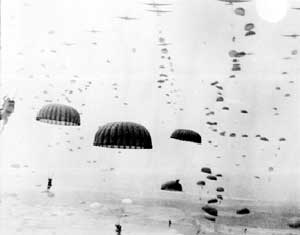 |
The US Airborne at War
By Evan Allen
I started planning for this article with the intention of writing a simple guide to helping paint US Airborne troops ready for the battlefield, and a few useful bits of information thrown in as well. The more I looked for information on these superb fighting Divisions the wider the scope of the article became and so I’ve included some history of the Airborne Divisions and also the major battles they fought in.
During my service with the Air force I qualified as a Parachute Rigger and had the opportunity to complete military static line parachute jumps.
|
|
The experience of being strapped tightly in a
harness, inside a noisy vibrating military aircraft, then leaping into
the cacophony of the slipstream, followed by the jerk of the canopy
opening, the relative serenity of drifting to touchdown and… all in
just over a minute from 1000ft has left me with an enduring affinity
towards creating airborne forces in miniature.
It probably wouldn’t surprise you to know that I have a large US airborne force with a glider company in progress and a largish Fallschirmjager force as well and when I get the opportunity to make figures for British Airborne I will, no doubt, build a FoW army for them as well.
See Evan's uniform and colour guide for US Airborne forces...
Beginnings
Like most countries before WW II the US Army toyed with the idea of airborne troops but not in formations any bigger than battalion size. In January 1940, inspired by the Soviet airborne forces used in the invasion of Finland, a project under the command of Major William Lee was authorized to start training the first US airborne force at Ft Benning, Georgia.
|
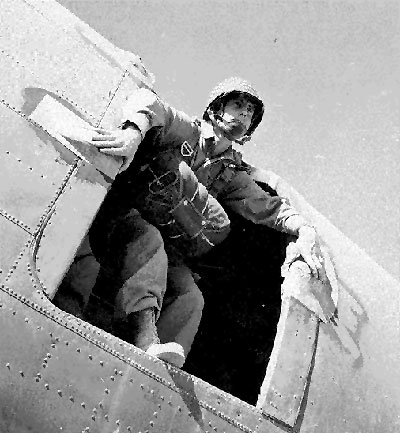 |
|
Here they developed the equipment and training that was to be used as the foundation for all US airborne forces.
The success of the German Fallschirmtruppen in 1940 also helped speed up development and by the time of the attack on Pearl Harbour there were three Parachute Infantry Battalions or PIB and one Airlanding Battalion (later to become a Glider Infantry Battalion or GIB) in existence.
|
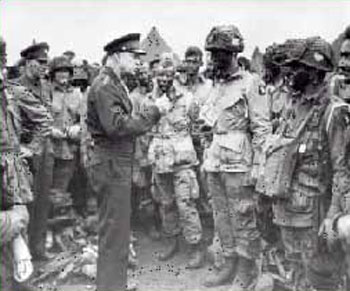 |
These formations were quickly used as the basis for expansion to four Parachute Infantry Regiments or PIR and Glider Infantry Regiment or GIR.
By now William Lee had been promoted to BrigGen and had visited the British airborne forces under formation and discovered they were planning whole Airborne Divisions. On his return to the US he recommended the same and on 15th August 1942 the now famous 82nd and 101st airborne divisions were activated. BrigGen Lee got command of the 101st and Gen Ridgeway got the 82nd.
The first US Airborne Combat jump was made by the 2nd Batt./503 PIR under LTC Edson Raff (later renamed 509 PIB). They were tasked, as part of Operation Torch, to take two key airfields to the south of Oran to help support the landings.
|
To achieve this they flew 1500 miles from the UK and of the 39 C-47’s that took off, 21 reached Tunisia and some landed their troops and a few sticks led by LTC Raff jumped. They were beaten to the airfields by US ground forces though. The 509th PIB jumped again later in the Tunisian campaign and captured airfields at Tebessa and Yaks les Bains. After this they were used as elite “leg infantry” for the remainder of the North African campaign.
|
The Divisions in the ETO (in order of activation)
82nd "All American"
The original 82nd Infantry Division was formed on Aug.25th 1917. In 1918 it deployed to France and took part in the final months of the Great War. Sergeant Alvin C York was a member of this fine division and it was called the “All American” division because it’s members came from (then) all 48 states.
At wars end it was demobilised and not reactivated again until March 1942 as an infantry division under Gen. Omar Bradley.
|
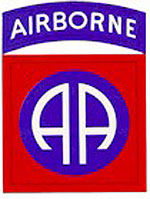 |
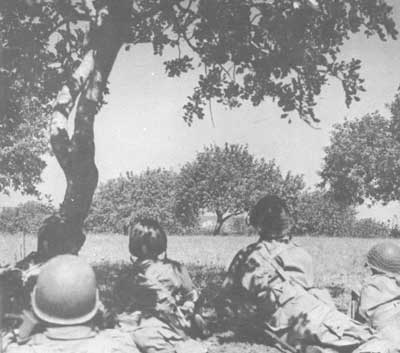 |
Then, in August 1942, it became the first
airborne division in the US Army. It consisted of the 504th, 505th PIR
and the 325th GIR.
April 1943 saw the Division travel to North Africa to carry out combat jumps and glider assaults during the invasion of Sicily on 9th July 1943 and again on mainland Italy during the Salerno landings on 13th Sept. 1943. The division was withdrawn from Italy to be sent to England for the Normandy landings but left behind the 504th PIR.
The 504th PIR was attached to “Old Ironsides” 1st Armored division for the Anzio landings and it was here that the US Airborne acquired the sobriquet of “Devils in baggy pants” from a captured German officers diary entry.
On arrival in England the now veteran airborne division with two combat
jumps added the 507th and 508th PIR’s to its line up for “Operation
Neptune” the airborne part of “Operation Overlord”.
|
|
There are plenty of books on the Normandy drops so I’m not going to go
into any detail here apart from the division spent 33 days fighting
continuously and suffered over 5,000 casualties in the process, a huge
amount for an airborne division.
Now the 82nd was added to XVIII Airborne Corp with MajGen James Gavin taking over command from General Ridgeway who went on to command the new Airborne Corps.
From the 82nd the 507th PIR left to join the newly arrived 17th Airborne Division and the 504th PIR returned from Italy to its 82nd parent in time to take part in “Operation Market Garden”.
Again I won’t go into any detail on this famous battle other than to
mention the river crossing carried out by Maj. Julian Cook’s 3rd
Battalion/504th PIR immortalized in the movie “A bridge to far”.
After
Market Garden the 82nd returned to France for rest and refitting until
the German attack in the Ardennes, better known as “The Battle of the
Bulge”, occurred. The 82nd was thrown into action to hold one shoulder
of the German penetration and fought ferociously until after the Bulge
was reduced and then continued on into Germany fighting as leg infantry
until the end of the war. Once Germany surrendered the 82nd was sent to
Berlin as part of the occupying force. Returning to the United States
in January 1946 the “All American” airborne division became a Regular
Army Division and made it’s home at Ft Bragg in North Carolina where it
resides today.
|
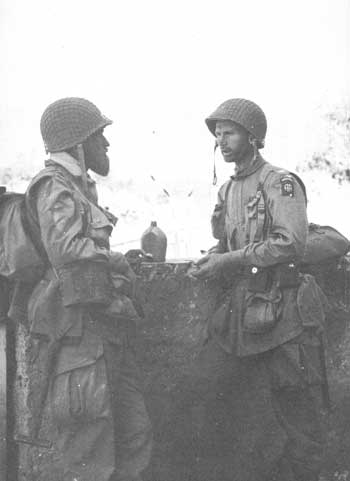 |
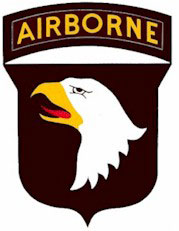 |
101st “Screaming Eagles”
The 101st was an infantry division that was created in Nov.1918 for service in WW I but was deactivated only a month later. It was reactivated as an “Organised Reserve Unit” in 1921. In 1942, when it was decided to make the division an airborne unit, it was transferred from the reserve to the Regular Army and in it’s airborne guise was activated at Camp Claiborne, Louisiana under the now Major General William Lee.
This is the division made even more famous by the TV series “Band of Brothers” about “Easy” company 2/506 PIR. At inception it consisted of the 502nd PIR, 327th and 401st GIR. There was much discussion about the organization of the airborne divisions and it was later decided to add the 501st and then the 506th PIR’s to the 101st divisional strength. The division shifted its headquarters to Ft. Bragg and then after completing it’s training the division shipped out to the UK arriving in late 1943.
|
|
Unfortunately in February 1944 MajGen William Lee, Father of the airborne force, suffered a heart attack and was replaced by the 82nd divisional artillery commander BrigGen. Maxwell Taylor. The 101st division took part in “Operation Neptune” as part of “Overlord” as well and, again, I won’t go into any detail as there is plenty available.
After the Normandy operations, including helping clear the Carentan peninsular, had finished for the 101st it returned to England for refitting and also became part of XVIII Airborne Corps under LtGen. Ridgeway. The next operation was “Market Garden” where it was mainly involved in keeping “Hells Highway” open, capturing bridges in Eindhoven and over the Waal River. Afterwards, in November, the division was sent to Mourmelon in France for rest and refitting where, the German attack in the Ardennes found them still based. Quickly rushed to Bastogne by truck under the command of the divisional artillery commander BrigGen. McAuliffe they were quickly surrounded by the advancing German forces.
|
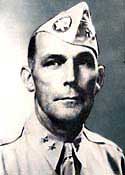 |
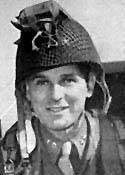 |
The encirclement of Bastogne lasted 5 days before the tanks of Gen. Patton’s 3rd army arrived to lift the siege and BrigGen. McAuliffe’s “nuts” reply to the German demand for the surrender of the strategically important town has also passed into airborne legend.
I would point out here that the 101st airborne did have a little help in holding Bastogne by, CCB 10th AD, remnants of CCR 9th AD, 705th Tank Destroyer Battalion, 755th, 969th Field Artillery Battalions and a few stragglers.
Once the crisis was over in Belgium the 101st returned to Mourmelon where it reverted to 1st Allied Airborne Army control and also became the first division to receive a Presidential Unit Citation for its heroic defense of Bastogne.
|
The last few days of the war saw the 101st sent to capture Hitler’s lair at Berchtesgaden. Finally the division was prepared to go to the Pacific to take part in the final assault on Japan, but after the Japanese surrender, was deactivated in France instead and shipped home. After being activated and deactivated several times the “Screaming Eagles” finally found a home as an active division at Ft. Campbell, Kentucky.
|
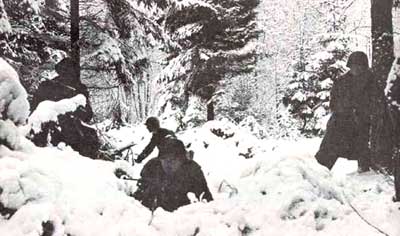 |
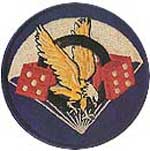 |
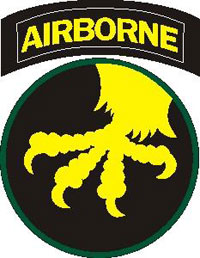 |
17th “Thunder from Heaven”
The 17th Airborne division was a brand new division activated in April 1943 at Camp Mackall, Nth. Carolina. The Divisional commander was Gen. William M Miley and the initial units assigned to this division consisted of the 513th PIR, 193rd and 194th GIR.
After completing initial training the division was shipped to the UK arriving in August 1944. Here the division came under XVIII Airborne Corps command and the 507th PIR joined the division from the 82nd airborne division.
Because the division hadn’t completed it’s training it was held in reserve during “Operation Market Garden” and then, in December by spectacular night flights, was flown from the UK to Rheims in France to take part in the Ardennes battles.
|
|
Initially used to guard a section of the Meuse River it was then sent to relieve the 28th Infantry Division and took part in clearing operations to push the German forces back out of Belgium until being pulled out of the line in February 1945 to prepare for “Operation Varsity” or the Rhine crossing.
Operation Varsity saw the division being dropped east of the Rhine River and was a complete success with both Paratroops and gliders landing close by their targets enabling all the objectives to be captured quickly. Then followed a period as leg infantry as the division advanced into Germany until the final surrender took place. Finally the division was used as occupation troops before being sent back to France in June 1945 for redeployment. In September “Thunder from Heaven” was sent home and disbanded.
|
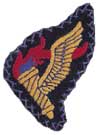 |
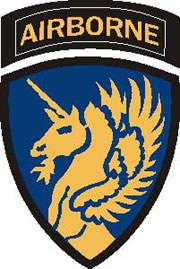
|
13th “Black Cats”
The 13th Airborne division was another brand new division activated in August 1943 at Camp Mackall, Nth. Carolina. The first divisional commander was MajGen. George Griner who was replaced in Dec.1944 by MajGen. Eldridge Chapman. The divisions initial units on activation were 515th PIR, 88th and 326th GIR. They arrived in Europe in Feb.1945 and had the 517th Regimental Combat Team or RCT assigned also, but then the division was kept in reserve for the Rhine crossing. Destined to remain “unblooded” they were assigned, along with the 101st Airborne, to the Pacific theater for the intended invasion of Japan, which wasn’t necessary after all.
The “Black Cats”, named that because they were activated on Friday the 13th, were sent home to be disbanded without firing a shoot in anger, except for the 517th RCT.
|
The 517th RCT were veterans of the Italian front where they had operated as leg infantry attached to the 36th Infantry division. The RCT’s units were, 517th PIR, 460th Parachute Field Artillery Battalion and the 596th Airborne Engineer Coy. and were led in combat by Colonel Rupert Graves. Eventually the RCT was pulled out of the Italian front to be readied as part of the 1st Airborne Task Force for the invasion of Southern France or “Operation Dragoon”
|
 |
|
Reassigned to the 7th Army they covered the eastern flank during its advance into France. Then on Dec. 6th the 517th RCT was sent to Soissons to come under LtGen. Ridgeway’s XVIII Airborne Corps and, eventual assignment to the 13th airborne division. This, apparently, was not a happy union as the experienced personnel of the 517th RCT chaffed under the untried command of the “Black Cats”
See Evan's uniform and colour guide for US Airborne forces...
|
Last Updated On Friday, June 6, 2008 by Wayne at Battlefront
|
|
|